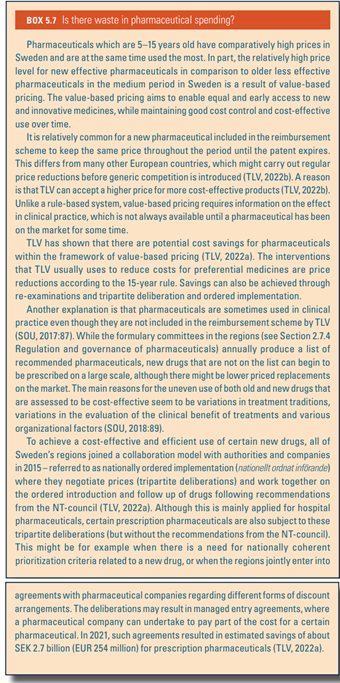-
21 May 2025 | Country Update
New measures to ensure medicine availability -
24 March 2025 | Country Update
Increased co-payments for prescription drugs
5.6. Pharmaceutical care
In 2021, turnover in the pharmaceutical market was SEK 54 billion (€5.1 billion). The cost per capita was about SEK 4400 (€414), which is about average compared with 19 other European countries (TLV, 2022a). The Swedish pharmaceutical market consists of five main areas with different systems of financing and payment (NBHW, 2022g). For more information about regulation, provision and pricing of pharmaceuticals, see section 2.7.4 Regulation and governance of pharmaceuticals.
- Prescription pharmaceuticals within the national reimbursement scheme (64% of total expenditure) are prescribed by physicians and collected by patients at pharmacies. Which pharmaceuticals are reimbursed is decided by the national agency TLV. Pharmaceuticals included in the reimbursement scheme are free of charge for children under 18. For adults, there is a high-cost protection scheme (see section 3.4.1 Cost sharing (user charges)). In 2021, patients paid one fifth out of pocket.
- Prescription pharmaceuticals outside the reimbursement scheme (3% of total expenditure) are prescribed by physicians and collected by patients in pharmacies. Pricing is set freely and individuals pay for them out of pocket in most cases.
- Over-the-counter pharmaceuticals (9% of total expenditure) are sold without prescription in pharmacies and retail outlets. These pharmaceuticals are not reimbursed. Pricing is set freely and individuals pay for them out of pocket in most cases.
- Pharmaceuticals for inpatient care (20% of total expenditure) are administered by care staff in hospitals and clinics. Discounts on listed prices are negotiated between the regions and pharmaceutical companies. For new pharmaceuticals, this is often done through tripartite deliberations between TLV, the regions (or the regions via the NT-council) and pharmaceutical companies. These pharmaceuticals are reimbursed in full with no fees for patients.
- Communicable disease pharmaceuticals in accordance with the Communicable Diseases Act (2% of total expenditure) are prescribed by physicians and collected by patients in pharmacies. These pharmaceuticals are reimbursed in full with no fees for patients. This applies to all pharmaceuticals prescribed for diseases classified as dangerous to the public (see section 5.1 Public health) where the prescribing physician has assessed that the medicine will reduce the risk of spreading infection, for example for hepatitis C and HIV.
A comparatively small share consists of inpatient pharmaceuticals provided by hospital pharmacies, whereas the majority of the market consists of prescription pharmaceuticals provided by approximately 1450 pharmacy outlets and additional online pharmacies. Sweden has relatively few pharmacies in sparsely populated areas and a very low density of pharmacies compared with other European countries (The Swedish Pharmacy Association, 2022). In 2021, a total of 58% of men and 73% of women collected at least one pharmaceutical prescription (birth controls included). The online sale of pharmaceuticals is, however, relatively high (see section 2.7.4 Regulation and governance of pharmaceuticals). In terms of volume, prescribed pharmaceuticals (excluding over-the-counter purchases) for high blood pressure were most common, followed by analgesics, antibiotics, antidepressants and pharmaceuticals for allergies (NBHW, 2022h).
If pharmaceuticals within the national reimbursement scheme have generic equivalents and are classified as interchangeable by MPA, the packaging with the lowest price is offered at the pharmacy. Each month, the pharmaceutical with generic competition in each package size group that has the lowest selling price per unit and enough supply throughout the price period are named “the period’s product” and should be offered to patients by pharmacies. The “period’s product” system for prescription pharmaceuticals is effective in terms of keeping prices low on pharmaceuticals with generic competition. In 2021, the prices for such pharmaceuticals were about 50% lower than the average of 19 other comparable European countries (TLV, 2022b). There is also a 15-year rule, which means that prices of pharmaceuticals within the reimbursement scheme that do not have generic competition are to be lowered (by TLV) after 15 years in the market. However, about 83% of pharmaceuticals on the Swedish market had no generic competition in 2021.
Box5.7 discusses the key issues in Sweden with regard to waste in pharmaceutical spending.
Box5.7
An ongoing development is the introduction of a so-called National Medication List, which will provide patients, health care staff, pharmacists and care providers with information about a patient’s prescriptions regardless of where in the country they have been prescribed (see Chapter 6.1 Principal health reforms).
Drug shortages can arise from several reasons, such as manufacturing or distribution problems, lack of active ingredients or unexpectedly high demand. To address these, a government-appointed inquiry has submitted an interim report proposing a legislative amendment. This would give the Swedish Medical Products Agency expanded powers to temporarily restrict the prescribing and dispensing of medicines in case of shortages.
The government sees this as an important step to strengthen the healthcare system’s ability to manage shortages, but also to strengthen preparedness so that the patients most in need have access to vital medicines. The government will now consider the submitted proposals and thereafter decide how to take them forward.
Authors
References
The high-cost protection scheme for pharmaceuticals is an important part of Sweden’s healthcare system, designed to limit patients’ out-of-pocket costs for prescription drugs. Since 2012, public spending on pharmaceuticals has risen faster than patient co-payments, meaning the state now covers a larger share of costs, affecting the system’s long-term sustainability. The goal is to ensure effective, cost-effective and equitable access to medicines based on need, with sustainable financing.
The government’s proposal increases the cost ceiling for out-of-pocket payments from SEK 2,900 to SEK 3,800 over a 12-month period. It also raises amounts within the high-cost ladder at each step and adjusts the first step, requiring patients to pay 75% instead of 50%. This means individuals could pay up to SEK 900 more annually. The total increase in patient fees is expected to be SEK 540 million in 2025, SEK 2.16 billion in 2026 and SEK 2.7 billion from 2027. The changes will take effect on 1 July 2025.

